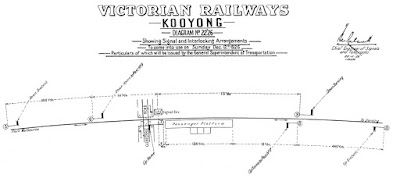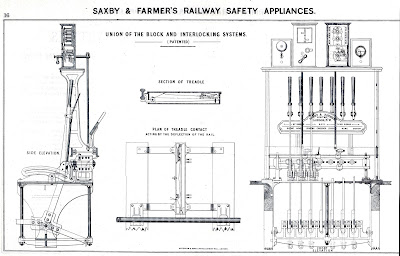Clue 1 - Melbourne is well served by an extensive public transport network. Successive state governments have been debating the need of removing level crossings to ease the traffic congestion.. . .
Clue 2
Clue 2 - This time our intrepid photographer has taken a rail journey to one of the inner suburb stations east of Melbourne
. . .
Clue 3
Clue 3 - This station opened in 1890.
The switch house was added in 1922 when the line was electrified.
. . .
Clue 4
Clue 4 - If you keep going along this line, you will end up in Glen Waverley.
REVEALAED
The Signal Box and Switch house at the Kooyong Railway Station Glenferrie Road crossing.
Kooyong needs to be manned for all trains and can not be switched out.
Research links:
vicsig
english-heritage (PDF)
signaldiagramsandphotos
Clue 2
Clue 2 - This time our intrepid photographer has taken a rail journey to one of the inner suburb stations east of Melbourne
Clue 3
The switch house was added in 1922 when the line was electrified.
. . .
Clue 4
REVEALAED
The Signal Box and Switch house at the Kooyong Railway Station Glenferrie Road crossing.
Kooyong railway station is located on the Glen Waverley line and serves the eastern Melbourne suburb of Kooyong having been opened on 24 March 1890.
The signal box at Kooyong Railway Station is located at the western end of platform 2, overlooking the Glenferrie Road level crossing. It was built to a standard Victorian Railway design consisting of a one-and-a-half-storey timber-framed building with a gable roof. External walls have weatherboard panels set between stop-chamfered timber posts. The roof has corrugated iron cladding, stop-chamfered bargeboards and turned timber finials. Six-pane timber-framed windows form a horizontal band along the south and east elevations providing the signalman with a clear view of the level crossing. The windows on the west elevation are shaded by a narrow corrugated iron awning on timber brackets. A pair of small two pane timber framed windows are found on the lower level of the south elevation.
The signal box exterior appears to remain in good original condition apart from some comparatively minor alterations. The glazing bars have been removed from some windows and others have had the upper two panes painted over. The metal stairs on the east side of the signal box appear to be a modern addition.
A switch house is located on the south side of the level crossing, opposite the signal box. It is a small red-brick building with a gabled terracotta tiled roof with scroll finials (one missing), exposed rafters at the eaves and a monitor type roof ventilator. Access to the switch house interior is through a V-jointed timber board door on the south elevation. The north elevation, facing the railway line, is blank apart from a series of terracotta floor vents. The west elevation contains a pair of window openings - one with a six pane timber framed window with figured glazing. The other window is sheeted over.
This apart, the switch house exterior appears to remain substantially intact.
The signal box exterior appears to remain in good original condition apart from some comparatively minor alterations. The glazing bars have been removed from some windows and others have had the upper two panes painted over. The metal stairs on the east side of the signal box appear to be a modern addition.
A switch house is located on the south side of the level crossing, opposite the signal box. It is a small red-brick building with a gabled terracotta tiled roof with scroll finials (one missing), exposed rafters at the eaves and a monitor type roof ventilator. Access to the switch house interior is through a V-jointed timber board door on the south elevation. The north elevation, facing the railway line, is blank apart from a series of terracotta floor vents. The west elevation contains a pair of window openings - one with a six pane timber framed window with figured glazing. The other window is sheeted over.
This apart, the switch house exterior appears to remain substantially intact.
There are two pedestrian gate levers, 13 and 14, they control the pedestrian gates. These remain with separate controls to the gates as there is a near by facility for Vision Australia with many visually impaired people using the crossing.
The tram signals are of led T light type, showing a Red or White T to trams. The same lever also operates the catch point (11 for "Kew" trams and 12 for "St Kilda" trams) these are still mechanical.
The gate stop lever (15) also operates the power to the tram/train square. When lever 12 is reverse the crossing is not operating and the power is switched to "tram", once lever 12 is returned towards normal the crossing starts operating and once the booms gates are horizontal the lever can be returned all the way to full normal and the power will be switched to "rail"
A near by set of pedestrian traffic signals are coordinated with the level crossing, and manual call is required by a push button on the block shelf. Once the traffic lights have responded the gate stop lever is then electrically released from the reverse position. A manual cancel is provided, which is only needed when the manual call has not been used.
The home signals are 10 for down and 9 for up trains. 10 shows medium speed and 9 shows full speed with a speed proving trip arm two thirds of the way along the platform.
The signal box is a building type that is unique to railways and had their origins in England in the 1840's with signalling platforms accompanied by a hut for the signalman. and towers at junctions.
The signal box as we know it today, i.e. a covered and glazed structure housing levers from which both signals and points are worked, was the invention of John Saxby who made a significant advance in mechanical interlocking between points and signals for which he obtained a patent in 1856.
Brief Kooyong railway station history:
Mon, 24 Mar 1890 Line Opened Burnley - East Malvern
Tue, 19 Dec 1922 Electrified Burnley - Darling
Sun, 20 Nov 1955 Duplicated Kooyong - Gardiner
Sun, 15 Dec 1957 Three Position Signalling Provided Heyington - Tooronga
Sun, 15 Dec 1957 Duplicated Heyington - Kooyong
Research links:
vicsig
english-heritage (PDF)
signaldiagramsandphotos









